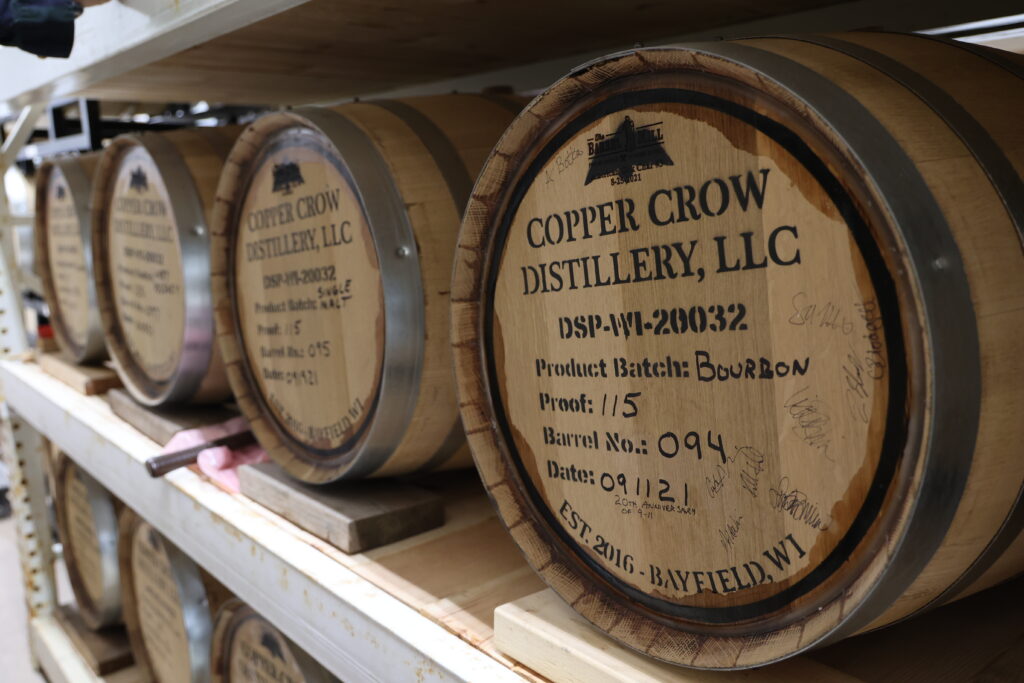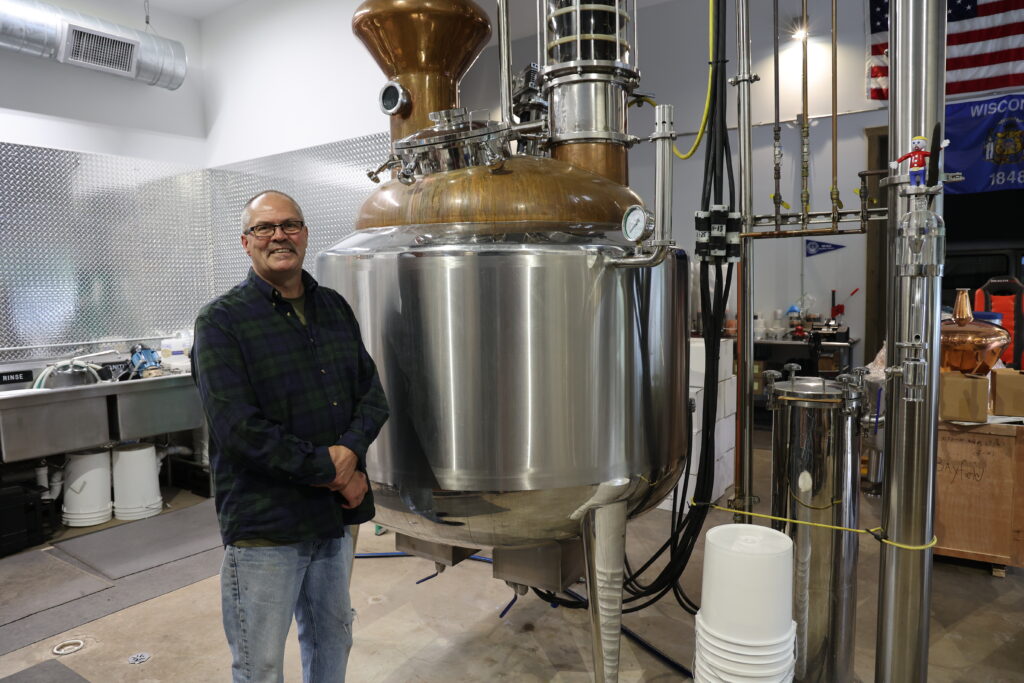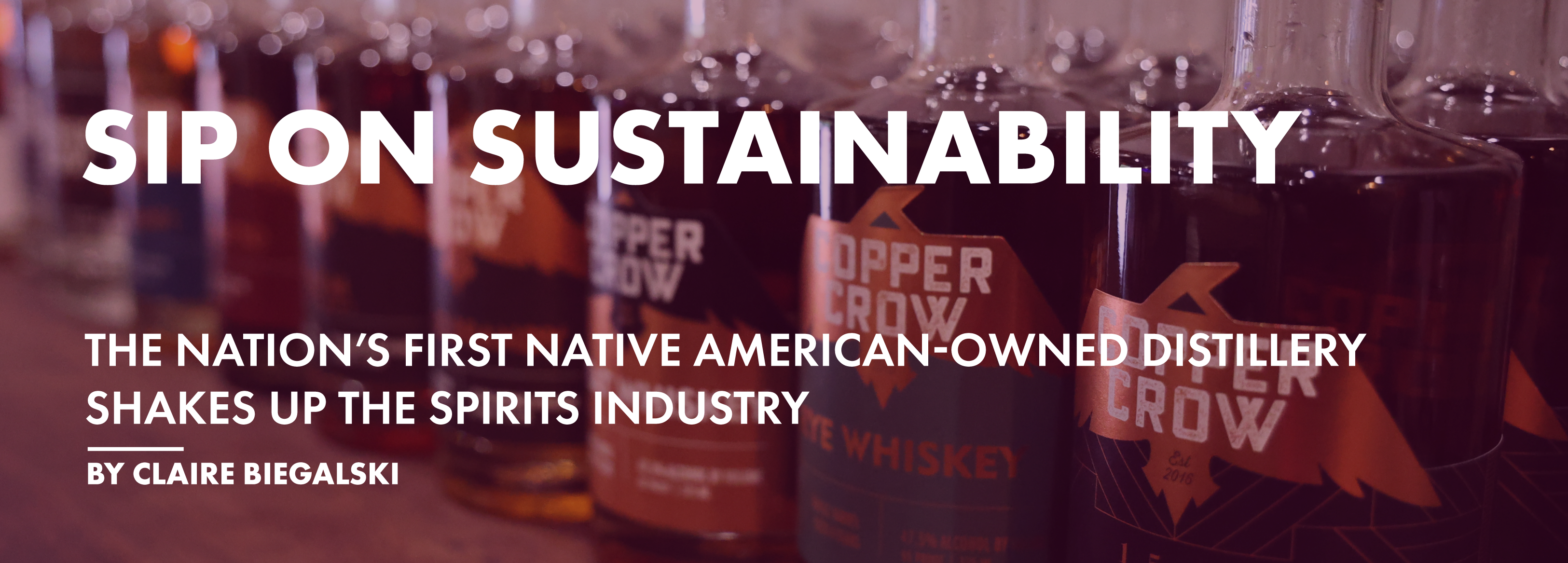The cloud-coated sky melts into an ethereal mist rolling off the Lake Superior waters and hangs low over a coastal fishing town in northern Wisconsin. Nature seems to breathe deeply with the rhythmic lapping of waves and the ancestral whispers of the Red Cliff region.
On the northeast shoreline of what is now known as the Bayfield Peninsula, a small yet unique distillery is nestled among strong emerald pines and autumn-kissed sugar maple trees. Outside, a couple sits at a picnic table sipping on apple brandy, eyes aglow from the twinkling fairy lights, warm spirits and friendly atmosphere. The soft hum of lively conversation and easy laughter fills the distillery inside. I lift my drink and sip slowly on strawberry basil-garnished gin, sharing in high spirits and smiles.

Past Bayfield, Wisconsin’s smallest yet enchanting city, the Copper Crow Distillery on the Red Cliff Reservation stands at the intersection of cutting-edge distillation techniques that use a cheese byproduct and the rich heritage of Ojibwe culture. This distillery blazes the path toward a more environmentally responsible and socially aware future. This future blends Ojibwe ethos and innovation with a product for mainstream consumption — ultimately rewriting the narrative of what it means to be a distillery with a conscience.
Mixology and fermentation
In 2017, Curt Basina and his wife, Linda, opened Copper Crow as the nation’s first Native American-owned distillery. Both are enrolled members of the Red Cliff Band of Lake Superior Chippewa, also known by the name Ojibwe. Ojibwe is a woodland culture that celebrates the world around them — the land, waters, forests, heavens and life within — this is reflected in the blend of scientific and artistic endeavors the couple infuse into Copper Crow.
The Basinas acknowledge that while alcohol dependency spans across all cultures, it is particularly stereotyped in the Native culture. For that reason, they are careful in how they operate and have declined to sponsor certain tribal events so as not to offend the tribe, members or the culture.

“This is a craft distillery where we have no intentions of being really big,” Linda says. “We hope to keep it that way — just knowing that we’re making a quality, good, and in some cases sustainable spirit, and complementing that with what is fresh and available during the season.”
Linda Basina, who was a high school special education paraeducator for 24 years, now works in the tasting room, managing the bartenders and mixologists, many of whom have worked with Copper Crow from the beginning.
“They’re great people, great bartenders. They do an amazing job. They are Copper Crow to people that walk in the door,” Linda says. “The vibe that they bring is what has brought us to where we are today.”
Copper Crow’s team of mixologists unleash their creativity on recipe nights where they experiment with flavors to create unique and delicious drinks. Linda says she pairs flavors like basil, mint and thyme with cucumbers, raspberries or blackberries harvested fresh from her own garden. In autumn, she looks at in-season flavors like apples and caramel, complementing them with the warmth of cinnamon and nutmeg.
Curt Basina’s passion lies on the distillation side, among gold liquid-filled fermentation vats that bubble to the brim with milk sugars and glucose-consuming yeast. With three vats full of fermenting whey, a waste product from cheese making, Curt continuously refines his distillation methods to create high-quality vodka and gin that is smooth, mellow and sweet around the edges. Copper Crow uses locally sourced whey from Burnett Dairy, located a few hours south in Grantsburg, Wisconsin.
Curt’s plunge into the spirits industry began after a career in highway patrol. He spent some time learning from other small local distilleries and through coursework. It wasn’t until he attended a course in Seattle, led by Berle “Rusty” Figgins, a master distiller and spirits educator, that he decided to dive into whey distillation.
“Rusty just immediately grabbed me and said, ‘You’re from Wisconsin, which is the Dairy State, you need to look at doing something with dairy,’” Curt says, explaining that Figgins was referring to whey, which is generally considered scraps in dairy. “So if you can take a waste product, and turn it into a value-added product, you’re gonna have a brand for your distillery.”
Copper Crow turned to UW–Stout to learn more about whey distillations and refine its process. Curt Basina worked with Steve Nold, a microbiology professor at the university, whose research team aimed to solve the problem cheese whey waste creates. Across 10 semesters, Nold and his students investigated every aspect of cheese whey fermentations to help refine Copper Crow’s process, but Curt nearly nailed it from the start.

Liquid gold
Whey is the cloudy, yellow-tinged liquid remaining after milk has been curdled and strained in the cheese-making process.
“Wisconsin alone creates 3.2 billion pounds of cheese annually,” Nold says. “And for every pound of cheese that is made, there are 9 pounds of cheese whey created — that is 27 billion pounds of cheese whey … and we haven’t figured out a good thing to do with it.”
Without sustainable practices, cheese whey is considered one of the biggest environmental pollutants in the dairy industry. Large industrial dairies often dispose of whey as wastewater, which is difficult and expensive to treat. Smaller dairies that can’t process their whey spray it on farm fields or put it in cess-lagoons or cesspits, which pose serious environmental hazards. Whey and other biowastes are a largely untapped, nutrient-rich source of sugars and protein.
Victor Ujor, an assistant professor of food science at UW–Madison, works in metabolic engineering and fermentation science to extract underutilized sugars in biowaste — like forest residues, corn stover and whey — to use as renewable sources.
“Coming up with very creative ideas on how to treat waste, to make something valuable out of waste, and hopefully to generate less waste … I hope we all as a society can begin to think along those lines as we go forward,” Ujor says.
More industries are realizing untapped potential resides among bits of grass, leftover corn cobs and the milky liquid gold that is whey. Recently, Curt was invited to be the keynote speaker at the American Distilling Institute’s 2023 Sustainability Summit to discuss the net positive effects of using a waste stream as a raw material. He embodies the mission of blending sustainable practices with the spirits industry to address nationwide environmental concerns.
“What I think is motivating Curt and what certainly motivates me is the idea that we could not create waste streams out of the leftover cheese whey. But instead, turn that cheese whey into a high-value product,” Nold says.
A whey forward
Nold envisions every cheese-producing dairy in Wisconsin setting up whey fermentations, while Ujor wants to see all Wisconsin dairy farms band together to store and use their whey in renewable ways. And the small but mighty Copper Crow tackles the waste problem one bottle of gin at a time.
All are working toward a future that values environmental sustainability.
Curt recently shared his whey distillation recipe with a craft distilling magazine for the entire spirits industry. Distillation is tightly held knowledge and intellectual property, but Curt hopes in sharing these details more distillers will use unconventional sugars to make spirits.
“All of us small craft distillers, we’re very willing to share information. We realize we’re not necessarily competitors; we’re in this for the betterment of the industry,” Curt says. “I think with whey, it’s just the fact there’s so much whey that just gets thrown out. If people understand there’s a fermentable sugar there but really don’t know how to go about doing it, I’m willing to share the information.”
From whey-based spirits crafted with locally sourced apple peels and hand-picked wild sumac to the Basinas who will join your table with warm and friendly conversation, Copper Crow stands as a testament to how a distillery can operate with a social and environmental conscience.
“It’s also part of that Ojibwe way, that you do things in a good way,” Linda says. “Do it in a good way so that you’re not offending people, that you attract the right people to the business. We’ve been lucky.”
